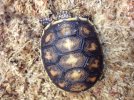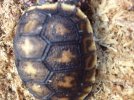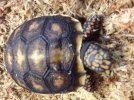Just wondering, has anyone ever heard of or bred redfoot/yellowfoot hybrids? I have a female yellow foot living with my red foot breeding group. She had eggs, and just last week they hatched. I can attach some pics of the baby's and the parents, but for now I was just wondering if this has ever been done before. The scutes on the head on the babys are neither redfoot nor yellowfoot, but have some traits of each.
You are using an out of date browser. It may not display this or other websites correctly.
You should upgrade or use an alternative browser.
You should upgrade or use an alternative browser.
Redfoot/yellowfoot hybrid?
- Thread starter RedfootsRule
- Start date
- Status
- Not open for further replies.
This is an interesting debate. Studies done in the field suggest that it happens, but the offspring just seem to look like one parent or the other- no visible differences they have noted. However, the two species also have strong- but not infallible- mechanisms in place to prevent interbreeding.
In captivity- lots of claims are made, but again, it seems as if the offspring look like one parent or the other. There are some unusual colorations once in a while, but the red-footed tortoise can have interesting colors without yellow-footed genes, so that does not really mean much.
Claims of tortoise hybrids are also tough because females both store and mix sperm for up to about 3 years. So, when you see female tortoise A mating with B, the eggs will share DNA from not only B, but every other male- C, D, G, and L- the female has been with.
This blending may also explain why tortoise hybrids do not look different- they are not 1/2 each of two different animals, they are 1/2 of one, and a bit each of several others- most of which will be the same species.
In captivity- lots of claims are made, but again, it seems as if the offspring look like one parent or the other. There are some unusual colorations once in a while, but the red-footed tortoise can have interesting colors without yellow-footed genes, so that does not really mean much.
Claims of tortoise hybrids are also tough because females both store and mix sperm for up to about 3 years. So, when you see female tortoise A mating with B, the eggs will share DNA from not only B, but every other male- C, D, G, and L- the female has been with.
This blending may also explain why tortoise hybrids do not look different- they are not 1/2 each of two different animals, they are 1/2 of one, and a bit each of several others- most of which will be the same species.
Madkins007 said:Claims of tortoise hybrids are also tough because females both store and mix sperm for up to about 3 years. So, when you see female tortoise A mating with B, the eggs will share DNA from not only B, but every other male- C, D, G, and L- the female has been with.
This blending may also explain why tortoise hybrids do not look different- they are not 1/2 each of two different animals, they are 1/2 of one, and a bit each of several others- most of which will be the same species.
Can you explain this in greater detail? Or perhaps clearer? I've heard of the idea of multiple 'fathers' in a single clutch but not of multiple 'fathers' in a single egg.
Am I reading it differently than what you intended?
What Madkins is saying is that, because 1.) females can store sperm for years and 2.) you have one YF with a multiple RFs...
...without genetic testing of the hatchling in question, you'll never know exactly what it is:
- an actual 50/50 redfoot x yellowfoot cross
- an animal that is predominantly redfoot with a small (<50) percentage of YF in it...OR
- just an uniquely-colored redfoot
...without genetic testing of the hatchling in question, you'll never know exactly what it is:
- an actual 50/50 redfoot x yellowfoot cross
- an animal that is predominantly redfoot with a small (<50) percentage of YF in it...OR
- just an uniquely-colored redfoot
I can pass no judgement on if this female could have mixed sperm, because I've only had her for a year, and I have no clue where she came from. I was driving down the road one day to the store and saw her walking out in the middle of the road. I brought her home and could never find her owner, so now she lives with my red foot herds. I don't know if she's ever bred before. I'll post some pics of the hybrid hatchlings soon. I found an old thread on here with this picture.
http://i29.photobucket.com/albums/c277/matt41gb/100_2402.jpg
One of the babys has the dark lines on the plastron just like the yellow foot, and they all have a strange mixture of head patterns with traits of each species.
http://i29.photobucket.com/albums/c277/matt41gb/100_2402.jpg
One of the babys has the dark lines on the plastron just like the yellow foot, and they all have a strange mixture of head patterns with traits of each species.
Its a funny thing about intergrade tortoises. Its not like dogs and cats, with the offspring looking like a mixture of the two parents. Intergrade tortoise babies take on the characteristics of either - or, not of both. I have intergrade Manouria emys emys/emys phayrei. Some of them look like Mep and some of them look like Mee, but none of them of the 19 that hatched, ever looked like a mixture of both.
I'd be willing to bet that is a redfooted tortoise. Yellowfooted babies are quite different in coloration when hatchlings. Also, note the single horizontal dot right above the nose. Yellowfooted tortoises have two vertical dots that are directly above the nares with no dots between the nares and the dots.
Notice the color of these hatchlings, and the placement of the two vertical yellow spots on the nose:
http://www.tortoiseforum.org/Thread...ortoises-Geochelone-Denticulata#axzz23UA38Vpt
Notice the color of these hatchlings, and the placement of the two vertical yellow spots on the nose:
http://www.tortoiseforum.org/Thread...ortoises-Geochelone-Denticulata#axzz23UA38Vpt
emysemys said:I'd be willing to bet that is a redfooted tortoise. Yellowfooted babies are quite different in coloration when hatchlings. Also, note the single horizontal dot right above the nose. Yellowfooted tortoises have two vertical dots that are directly above the nares with no dots between the nares and the dots.
Precisely. A trait of red foots. Now look right behind that and not the two vertical elongated dots..
You see the same thing on these redfooted babies:
http://www.redfootman.net/
That is quite common to see in redfooted tortoises.
emysemys said:That is quite common to see in redfooted tortoises.
I've myself bred over 100 hatchlings red foots, and have never seen this coloration. Also, in the picture you posted of the yellow foots, notice how in each scute there is a variegated, speckled yellow and black? In my pictures, you can see in each scute the same kind of marks in red and black. I have never before seen this in my hatchling red foots. The YF that is their mother had a clutch a few months ago, and they had the same marks and same odd head markings. I have two breeding RF females in the same pen and their babys always look like the onein this picture.
Also the black pattern on the plastron is another thing none of my other babys have had.
Here are the other two hybrids.
RedfootsRule said:emysemys said:That is quite common to see in redfooted tortoises.
I've myself bred over 100 hatchlings red foots, and have never seen this coloration. Also, in the picture you posted of the yellow foots, notice how in each scute there is a variegated, speckled yellow and black? In my pictures, you can see in each scute the same kind of marks in red and black. I have never before seen this in my hatchling red foots. The YF that is their mother had a clutch a few months ago, and they had the same marks and same odd head markings.
Also the black pattern on the plastron is another thing none of my other babys have had.
Here are the other two hybrids.
Oops the first picture wasn't supposed to be there ignore it...
Attachments
-
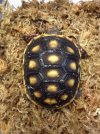 photo-21.JPG380.7 KB · Views: 89
photo-21.JPG380.7 KB · Views: 89 -
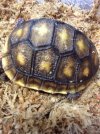 photo-10.JPG366.8 KB · Views: 76
photo-10.JPG366.8 KB · Views: 76 -
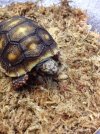 photo-11.JPG382.4 KB · Views: 77
photo-11.JPG382.4 KB · Views: 77 -
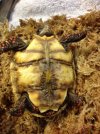 photo-12.JPG328.4 KB · Views: 68
photo-12.JPG328.4 KB · Views: 68 -
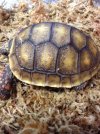 photo-13.JPG369.2 KB · Views: 94
photo-13.JPG369.2 KB · Views: 94 -
 photo-14.JPG308.4 KB · Views: 67
photo-14.JPG308.4 KB · Views: 67 -
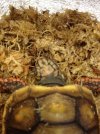 photo-15.JPG313.9 KB · Views: 70
photo-15.JPG313.9 KB · Views: 70 -
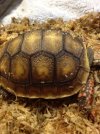 photo-16.JPG290.3 KB · Views: 75
photo-16.JPG290.3 KB · Views: 75 -
 photo-19.JPG272.1 KB · Views: 76
photo-19.JPG272.1 KB · Views: 76 -
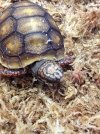 photo-18.JPG401.1 KB · Views: 90
photo-18.JPG401.1 KB · Views: 90
RedfootsRule said:Here is the first hybrid.
Very pretty baby. I see both redfoot and yellowfoot characteristics in this tort.
Eweezyfosheezy said:RedfootsRule said:Here is the first hybrid.
Very pretty baby. I see both redfoot and yellowfoot characteristics in this tort.
Thanks. I'm very sure they're hybrids. When people hear the word "hybrid" they immediately think its fake and don't even bother to look at the evidence. I don't think people understand there is no reason it CAN'T happen. Geochelone carbonaria and geochelone denticula are closely related species..
As madkins said, they're chararistics will typically lean towards one species. These babies seem to be slightly more red foot.
TortoiseBoy1999 said:
We shall call the hybrids orange-foots...Lol
Storing and mixing sperm- the idea is pretty simple- the female can keep sperm viable for a few years, and when storing it, mixes it so the sperm attacking the new egg can be from ANY of the males it has been with in the last few years. I assume that a different sperm fertilizes each egg, and that each sperm will be from one individual, but- I would also bet (but do not know) that the characteristics of the sperm storage organs in each species are subtly different and benefit the mothers species more than others, and that the strongest, most motile sperm would 'win'.
(I did goof up on the way I described it earlier- I blame low levels of ice cream in my system.)
As far as determining the potential cross from the coloration and characteristics of a hatchling- I would suggest that it might be more helpful to wait until it looses the hatchling characteristics. What is the carapace base color? Do the areoles blend or do they have sharper edges? What is the scalation pattern on the top of the head? What is the ratio of the seams between the plastron scutes? Where do the gulars end compared to the top of the carapace? Does it retain the denticulation of the marginals?
So far, they are really pretty color variations. Calling them crosses without DNA evidence or stronger anatomic evidence is a bit iffier in my opinion.
(I did goof up on the way I described it earlier- I blame low levels of ice cream in my system.)
As far as determining the potential cross from the coloration and characteristics of a hatchling- I would suggest that it might be more helpful to wait until it looses the hatchling characteristics. What is the carapace base color? Do the areoles blend or do they have sharper edges? What is the scalation pattern on the top of the head? What is the ratio of the seams between the plastron scutes? Where do the gulars end compared to the top of the carapace? Does it retain the denticulation of the marginals?
So far, they are really pretty color variations. Calling them crosses without DNA evidence or stronger anatomic evidence is a bit iffier in my opinion.
- Status
- Not open for further replies.
Similar threads
- Replies
- 5
- Views
- 3K
- Replies
- 62
- Views
- 12K
- Replies
- 0
- Views
- 861
- Replies
- 2
- Views
- 1K
